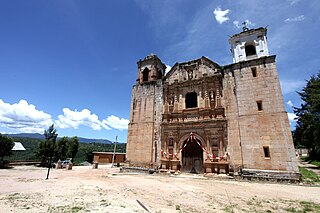Related Research Articles

The Zapotec languages are a group of around 50 closely related indigenous Mesoamerican languages that constitute a main branch of the Oto-Manguean language family and which is spoken by the Zapotec people from the southwestern-central highlands of Mexico. A 2020 census reports nearly half a million speakers, with the majority inhabiting the state of Oaxaca. Zapotec-speaking communities are also found in the neighboring states of Puebla, Veracruz, and Guerrero. Labor migration has also brought a number of native Zapotec speakers to the United States, particularly in California and New Jersey. Most Zapotec-speaking communities are highly bilingual in Spanish.
A macrolanguage is a book-keeping mechanism for the ISO 639 international standard of language codes. Macrolanguages are established to assist mapping between different sets of ISO language codes. Specifically, there may be a many-to-one correspondence between ISO 639-3, intended to identify all the thousands of languages of the world, and either of two other sets, ISO 639-1, established to identify languages in computer systems, and ISO 639-2, which encodes a few hundred languages for library cataloguing and bibliographic purposes. When such many-to-one ISO 639-2 codes are included in an ISO 639-3 context, they are called "macrolanguages" to distinguish them from the corresponding individual languages of ISO 639-3. According to the ISO,
Some existing code elements in ISO 639-2, and the corresponding code elements in ISO 639-1, are designated in those parts of ISO 639 as individual language code elements, yet are in a one-to-many relationship with individual language code elements in [ISO 639-3]. For purposes of [ISO 639-3], they are considered to be macrolanguage code elements.

The Chatinos are an indigenous people of Mexico. Chatino communities are located in the southeastern region of the state of Oaxaca in southern central Mexico. Their native Chatino language are spoken by about 23,000 people, but ethnic Chatinos may number many more. The Chatinos of San Juan Quiahije call themselves neq-a tnya-j and their language Chaq-f tnya-b.
Huave is a language isolate spoken by the indigenous Huave people on the Pacific coast of the Mexican state of Oaxaca. The language is spoken in four villages on the Isthmus of Tehuantepec, in the southeast of the state, by around 20,000 people.
San Juan Quiahije is a town and municipality in Oaxaca in south-western Mexico. It is part of the Juquila District in the centre of the Costa Region. The origin of the name Quiahije is not known, some people conjecture it might mean "Stone Forest" in the Zapotec language.

Santa Catarina Ixtepeji is a town and municipality in Oaxaca in south-western Mexico. It is part of the Ixtlán District in the Sierra Norte region.

Tlacolula District is located in the east of the Valles Centrales Region of the State of Oaxaca, Mexico.
Loxicha Zapotec is a Zapotec language of Oaxaca, Mexico. It is one of the most populous varieties of Zapotec, and the majority of speakers are monolingual.
Tlacolula Valley Zapotec or Valley Zapotec, known by its regional name Dizhsa, and formerly known by the varietal name Guelavia Zapotec is a Zapotec language of Oaxaca, Mexico.
The Codex of Santa Catarina Ixtepeji is a late 17th-early 18th century bilingual codex in the Spanish and Zapotec languages. It is a 7-foot-long scroll (2.1 m), a hand-painted history and map recounting part of the history of Santa Catarina Ixtepeji, in the Ixtlán District in the Sierra Norte region of Oaxaca in southwestern Mexico. It had been held in the hands of private collectors into the 20th century, and was re-discovered and identified as part of the holdings of the American Geographical Society Library at the University of Wisconsin–Milwaukee in early 2012, as the result of efforts of scholars at UWM, Marquette University and the Universidad Nacional Autónoma de México.
Morelos Nahuatl includes varieties of the Nahuatl language that are spoken in the state of Morelos, Mexico. In Morelos, Nahuatl is spoken in the communities of Cuentepec, Hueyapan, Santa Catarina, Xoxocotla, Atlacholoayan and Tetelcingo. But Tetelcingo Nahuatl is usually considered a separate variety due to its highly innovative phonology, and has very low mutual intelligibility with the other Morelos variants. Ethnologue also considers the varieties of San Felipe Tocla and Alpanocan to belong to the Morelos Nahuatl group of dialects although they are located in the state of Puebla. The dialects belong to the Central dialects closely related to Classical Nahuatl.
Chichicapan Zapotec is a Zapotec language of Oaxaca, Mexico. The town's name is spelled as both Chichicápam and Chichicapan.
Yalálag Zapotec is a Zapotec language of Oaxaca, Mexico, spoken in Hidalgo Yalalag, Mexico City, Oaxaca City, Veracruz.
Yatee Zapotec and Lachirioag Zapotec are dialects of a Zapotec language of Oaxaca, Mexico.
Santa Catarina Albarradas Zapotec, also known as San Antonio Albarradas Zapotec, is a Zapotec language of Oaxaca, Mexico. Speakers find neighboring Santo Domingo Albarradas Zapotec marginally intelligible (80%), but the reverse is not the case (50%).
Albarradas Zapotec, in full Santo Domingo Albarradas Zapotec, is a Zapotec language of Oaxaca, Mexico. It is spoken in the towns of Santa María Albarradas, Santo Domingo Albarradas, and San Miguel Albarradas. The language of neighboring Santa Catarina Albarradas and San Antonio Albarradas is not mutually intelligible.
Ixtlán Zapotec is a Zapotec dialect cluster of Oaxaca, Mexico.
San Baltazar Loxicha Zapotec is a Zapotec language spoken in southern Oaxaca, Mexico. It is spoken in the towns of San Baltazar Loxicha and Santa Catarina Loxicha. It is not the same language as the other dialects spoken in towns named Loxicha, but it is in the same branch of Zapotec.
Quiegolani Zapotec is a Zapotec language of Oaxaca, Mexico.
Zapoteco de Valles, del noreste is a name used by INALI for a variety of Zapotec recognized by the Mexican government. It corresponds to two ISO languages:
References
- ↑ "Signed languages of Mexico | SIL Mexico". mexico.sil.org. Retrieved 2023-05-02.